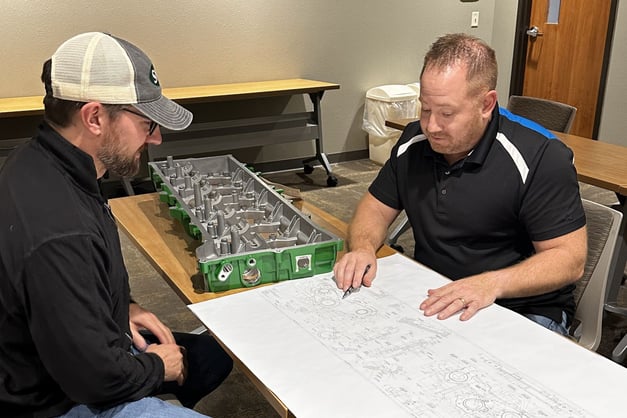Design changes. They are an inevitable part of manufacturing, yet they can aggravate even the most experienced parts manufacturer.
Design changes are notorious for adding time, headaches, and unplanned dollars to a project. They’ve also been known to sabotage solid business relationships. But, with the right approach, you can implement manufacturing design changes smoothly and cost-effectively.
Success is determined by how a design change is handled
When it comes to machined parts, designing with an eye on the machining process can increase a machinist’s performance, decrease the budget, and generate long-term savings in part costs.
Making design changes to a part currently in production is far more complex — including current inventory, schedules, and vendor purchase orders — and costly than making changes to a part in the design phase.
With that in mind, let’s cover 5 tips for handling manufacturing design changes successfully:
- Ensure Your Partner Has Engineering Expertise
- Demand Detailed Project Management
- Consider the Importance of Part Tolerances
- Dominate on Drawings
- Keep Things Professional
1. Ensure Your Partner Has Engineering Expertise
You know that there’s no substitute for experience. What you’re looking for is a team that works on hundreds of design changes each year and has a customer base of old and new product development.
Talented manufacturing engineers can immediately assist with design changes as well as rapid prototype services for cast and machine tools. Quickly generating prototype parts allows their performance to be tested before they’re manufactured in large quantities.
One example of engineering expertise is designing parts that are easy to hold. Proper workholding reduces the possibility for error and ensures parts are machined to the right specifications.
Approaching design with years of experience and knowledge distinguishes a machining partner and keeps customers coming back.
2. Demand Detailed Project Management
Project management can also set a machine shop apart from others. Having an in-house team — manufacturing engineers and full-time fixture building machinists — means you’ll get reliable performance, and you’ll feel confident about that project.
In the design phase, the team works with the customer to provide print feedback for machinability, geometric dimensioning and tolerancing (GD&T), and guidance so the part is as cost-effective as it can be. Customers also get valuable input on machining designs prior to launch, including design review and advanced product quality planning (APQP) meetings.
Consider if a shop has in-house experts on castings who develop multiple foundry partnerships. The more they collaborate to tackle design changes, the quicker — and more successful — the changes are handled.
Reliable foundry partnerships are magnified when the right tools are available to deliver design changes swiftly. Proper machine tooling, machining centers, and programming capabilities are needed when manufacturing machined castings. For instance, with 3-D CAD fixture expertise (and a solid plan), design changes happen much more efficiently.
3. Consider the Importance of Part Tolerances
Consider this: Just about anything can be perfectly machined once. But can thousands of parts be run with the same consistency? Yes, but it requires a combination of the right tools and human expertise to do the job right every single time.
Part tolerance is one obvious way to measure quality and consistency. Tolerance is a dimensional range that’s deemed acceptable by the designer and is based on the part’s function, fit, and form. Not meeting tolerance can result in more foundry or machine scrap, a product not functioning properly, tooling rework, extra machining, and/or warranty issues from a customer.
Exact means exact, no matter what the project. However, it’s important to remember that a tighter tolerance can result in additional cost, additional fixturing, or longer cycle times (because slowing down the machine may be the only way to achieve some tight tolerances). To keep costs down, designers should only apply tight tolerances to critical areas.
4. Dominate on Drawings
Drawings from customers have a huge influence on a shop’s success. To produce the best and most cost-effective part, time must be spent on drawings. Great prints produce great parts; this holds true for design changes.
A print is the primary direction to a machinist, and it needs to be clear and legible. Top machine shops evaluate a print to their best abilities, planning all steps based on what is available. That drawing holds the key to avoiding mistakes and saving money, which are likely top-of-mind during design changes.
5. Keep Things Professional
This final point isn’t as process-related as the other four, but it’s important. One reason why “design changes” strike fear in the hearts of confident machinists is because of their past experiences.
Projects requiring change are often presented negatively and loaded with emotional baggage. Remember, meeting tight tolerances is a challenging art, and mistakes are bound to happen.
So, be professional and get the best from a machine shop by following this simple checklist:
[ ] Communicate clearly and often; confront problems and resolve issues fairly
[ ] Consult on design changes; many machinists have years of experience and training
[ ] Be financially aware; pay bills on time, don’t use the shop as a free quoting service, and don’t beat them up on part costs
[ ] Partner with the shop; treat people as team members; dedication and extra effort result from mutual respect
That list may not be “design change” specific, but it’s appropriate for the topic. Design changes are no fun for anyone, but they happen … and people get emotional.
If reading about successful manufacturing design changes has piqued your interest in machine shops, see what benefits a high-end machine shop brings to a partnership. This Valued Added Services Checklist shares some things you should expect: simpler processes, shorter lead times, better communication. Click below to get your copy!




